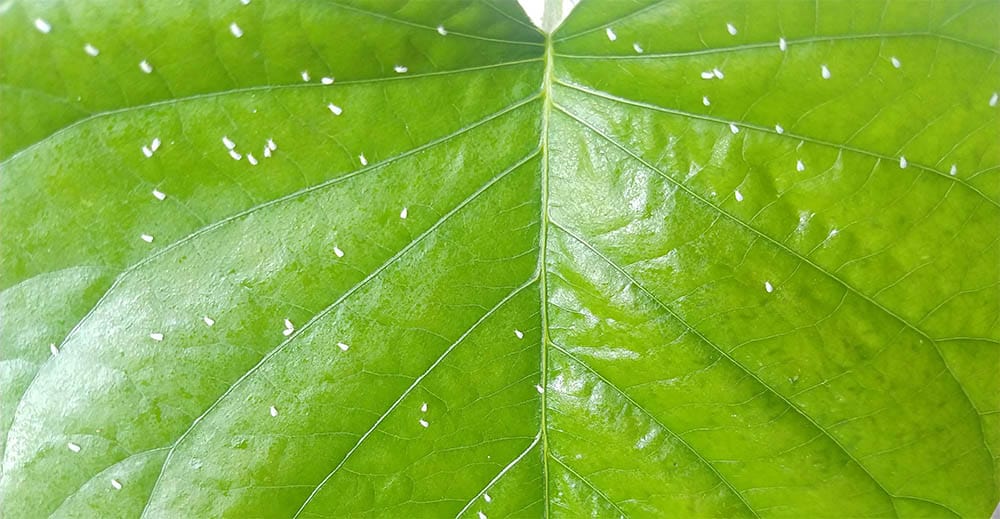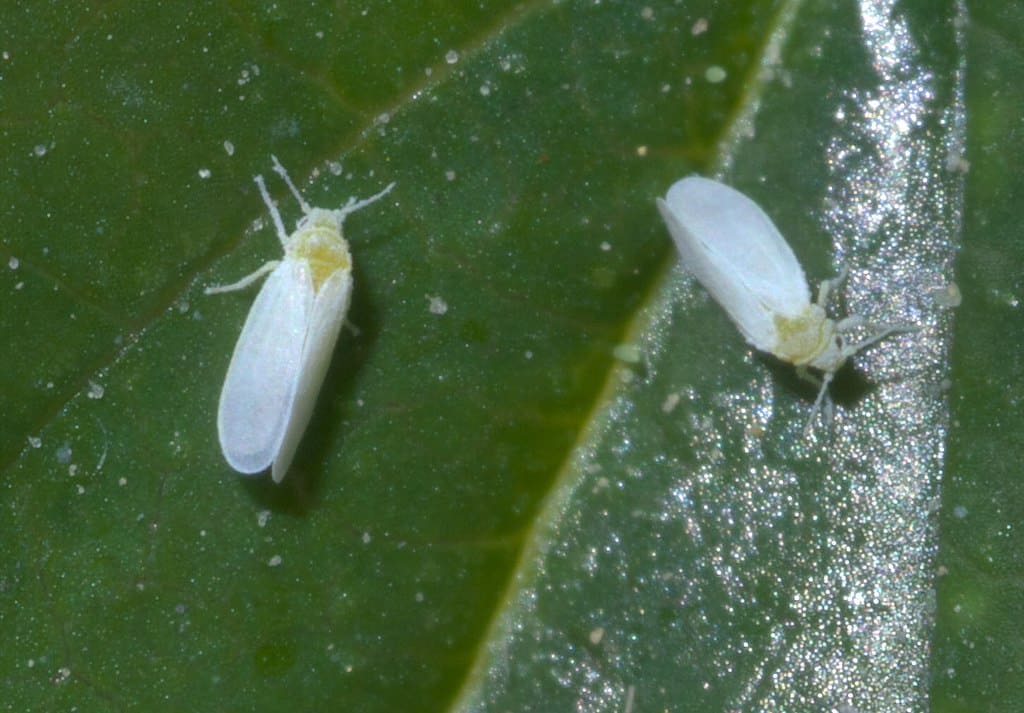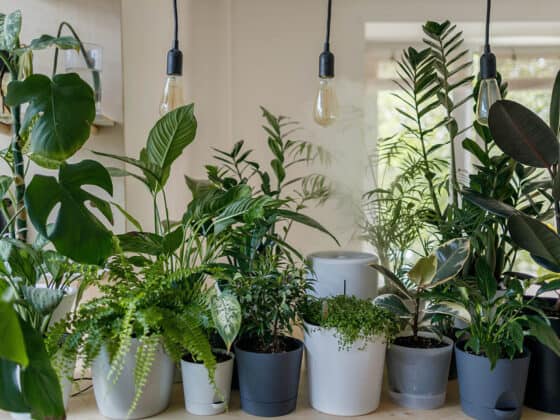If you are even just a little bit familiar with whiteflies, you might already know just how tenacious these little pests can be once they show up in your home. Although mostly just a nuisance for plant owners, these bugs can actually wreak havoc on your plant collection, leaving many wondering what to do once they realize they’ve got a whitefly issue.
Whiteflies are small, white, moth-like insects that feed on the sap of many different plants. Although mostly considered unsightly and messy, if left untreated, whitefly infestations can cause significant health issues for houseplants, which will persist until treatments are implemented.
Whiteflies are prolific plant pests mainly due to their quick lifecycle and their mobility, making it easier for a population to grow and spread to new plants. Oftentimes, the first sign of an infestation is the appearance of a cloud of adults hovering around a plant that has been bumped or moved. At this point, you can bet your plant is harboring a substantial infestation, and action must be taken.
The good news is that there are treatments available for whiteflies, and knowing how to best use them to your advantage only requires a basic understanding of how whiteflies live, reproduce, and spread.
In this article, we’ll go over the most commonly asked questions about whiteflies to equip you with the knowledge necessary to select, deploy, and (likely) repeat the treatment options that work best for you and your home.
Ready to dive straight into whitefly treatment options?
What Are Whiteflies?
“Whitefly” is a term that actually describes over 1,500 different species of small, white, moth-like, winged insects that feed on the sap produced in a plant’s phloem. They use specialized mouthparts to pierce through the plant’s outer tissue to access the sugary sap.

These insects are very common outdoors, found on several different types of plants, but are often controlled by cold or freezing temperatures, which keeps their numbers in check. Indoors, however, whiteflies thrive in the dry, warm conditions often kept in our homes, and a population can proliferate rather quickly on houseplants.

How Big Do Whiteflies Get?
Adult whiteflies are small, often only reaching about 1/10” in length. Most species tend to have a very recognizable wedge- or heart-shaped body, complete with a set of powdery, moth-like wings.
Juvenile whiteflies are even smaller, often needing a keen eye or a magnifying glass to see properly. These juvenile nymphs are pale green and wingless but have legs they use to crawl to new parts of the plant, where they feed as they morph through several stages before becoming adults themselves.
Do Whiteflies Fly?
It may sound obvious from their name, but yes, whiteflies can fly. Adults have a full set of wings that they can use to fly to different parts of a plant or even go in search of new plants to feed on.
Juveniles do not have wings and, instead, have six legs which they use to crawl to new areas in search of a place to feed. At some point, these juveniles will pupate into full-grown adults, and their wings will have grown in.
Where Do Whiteflies Come From? How Do Houseplants Get Them?
Just like most other houseplant pests, whiteflies are very common outdoors. In most cases, they end up on our houseplants because we inadvertently carry them, as either adults or juveniles, into our homes.
Juveniles are often so small that they can easily attach to pant legs or shirt sleeves without us even realizing we are brushing up against or working on a plant infested with whitefly. These little nymphs can then be carried into the house on our clothing and deposited on houseplants as we water or rearrange them.
Adults are winged and so light that even a small breeze can blow them in through an open door or window. Once inside, they’ll naturally seek out a refuge to hide in, with houseplants being their only real option.
Most commonly, however, whiteflies are brought into our homes on other houseplants we bring indoors. This can be a newly purchased plant we are excited to add to our collection or just an old plant we set outside to get some sun during the nicer seasons.
This is why it is always good to isolate any new plants for a few days before incorporating them into your collection. This allows you to assess the plant to ensure you aren’t bringing in any pests or diseases. The same goes for plants you bring back in from a stint outside.
Why Does My Houseplant Have So Many Whiteflies?
Many of us realize we are dealing with a whitefly infestation only when we notice the small cloud of white specks rising from the plant when we disturb it. This little “snow flurry of panic,” as I like to call it, is a collection of adult flies taking flight when we get near the plant.
By the time you are seeing adult flies around your plant, you can be sure there is a very prolific population of juveniles taking up residence within the leaves and stems, as well.
This happens because the lifecycle of most whitefly species is very fast. The whole process takes less than three weeks from egg to adult, and the whole thing speeds up when temperatures are warmer. Unfortunately, we tend to keep our homes right around temperatures that are ideal for whiteflies to thrive.
Also, at any given moment, your plant is harboring every stage of a whitefly’s lifecycle. Females can lay several clusters of eggs staggered over their lifetime, which hatch in regular intervals. This means that there is then a constant supply of new adults pupating, ready to start the next lifecycle.
What Is the Lifecycle of a Whitefly?
As was mentioned above, a whitefly’s multi-part lifecycle only takes about three weeks to complete. All stages occur on the plant foliage and can be sped up in warmer temperatures.
Adult females will lay roughly 200-400 tiny, cigar-shaped eggs over the course of their lifetime, often in smaller clusters of about 30-40 on the underside of a plant’s leaves. Within just a few days, these egg clusters will hatch, producing tiny nymphs that crawl to new areas of the plant, where they settle and begin feeding.
These juveniles continue to feed as they molt through several different growth stages. Eventually, they reach a non-feeding stage where they attach themselves to a leaf and rest until they pupate into a new, winged adult.
What Does Whitefly Damage Look Like?
In general, whiteflies are considered to be mostly a nuisance since the amount of damage they inflict on a plant tends to be much less than other common pests.
However, because whiteflies are notoriously hard to eradicate and can build their population quickly, an infestation left untreated can create many health issues for a plant over time.
Whiteflies, like aphids, thrips, and more, are sap-sucking insects that feed on your houseplant at almost every stage of their life. Although the damage caused by their piercing mouthparts is minimal on an individual level, as populations grow, that damage can accumulate over time and drain the plant’s overall health.
With severe whitefly infestations, you might notice your plant is sporting yellowing spots of chlorotic tissue on its leaves. Over time, the entire plant might look like it is suffering or have an overall loss of vigor. It may begin to wilt, droop, or start shedding leaves prematurely.
Whiteflies also produce honeydew, a sticky excrement that can coat plant surfaces and structures. This honeydew promotes other fungal diseases and can disrupt the proper unfurling of new plant growth, causing deformities or tears.
Will Whiteflies Kill My Houseplants?
Although whiteflies can do a fair amount of damage to your houseplants if left unchecked, it is unlikely that they will kill them. It definitely can happen, but it isn’t common.
That being said, the damage whiteflies can cause to a plant shouldn’t be dismissed. Your plant might survive an infestation, but it isn’t going to look all that great with a huge population of pests sucking out its nutrient-rich sap.
The damage inflicted by a whitefly infestation will weaken a plant over time, making it much more susceptible to diseases, different pests, and other issues as its health continues to decline.
Can Plants Recover From Whiteflies and Whitefly Damage?
Once you realize you have a whitefly infestation, it is best to work quickly to eliminate them. Because the accumulation of physical damage is fairly gradual, as long as you deal with the infestation, a plant can usually bounce back to full health pretty fast.
Aside from physical damage, the reduction in whiteflies will lower the amount of honeydew covering the plant, which will help prevent fungal infections and limit the attraction of other pests. Part of your treatment should be to wash any sticky honeydew from plant surfaces to reduce unwanted side effects.
If you have areas of your houseplant that whiteflies have severely damaged, the best course of action might be to prune them off. A plant will spend a lot of energy trying to make repairs to damaged tissues, sometimes without ever making a full recovery. Really damaged leaves can just be removed, allowing the plant to invest that energy into other parts.
Will Whiteflies Go Away on Their Own?
Without treatment, whiteflies are happy to live off the plant they are infesting and just continue pumping out new generations. As long as the host plant produces enough sustenance and protection, the flies have no reason to leave.
If left unchecked, whitefly populations can grow to some impressively gross numbers. Obviously, their host plant will be suffering the entire time they are present, and the damage they inflict could lead to serious health issues or death.
More importantly, the longer a large population is allowed to continue thriving, the more likely it is that the whiteflies will find new homes and food sources in other plants. Rather than waiting to see if an infestation will leave on its own, you should take action to prevent them from spreading to the rest of your houseplants.
Are Whiteflies Harmful to Humans?
Whiteflies require plant sap as a food source and have developed specialized mouthparts to pierce through plant walls to access it. However, those specialized mouthparts pose no threat to humans, as they are not strong enough to get through our thick skin, so even if they wanted to bite us, they wouldn’t be able to.
How Do You Treat for Whiteflies?
After you realize you have a whitefly issue, it is best to implement treatments quickly to knock back and gain control over the population. Because these flies have fast lifecycles and are good at evading detection, they are known for being rather persistent pests, so targeting both adults and juveniles is the only way to gain the upper hand.
Your first move should be quarantine. Move your plant away from the rest of your other houseplants, being sure to minimize how much you disturb the flying adults. Aim for an isolated room, preferably cooler in temperature, to help slow the speed of reproduction.
Spraying your plant with water or wiping all plant structures with a damp cloth is a great start to reducing the number of eggs, juveniles, and pupating adults present on the plant. By removing the potential for new, sexually mature adults, you can interrupt the growth rate drastically.
Physical removal of the adults is also an effective strategy in reducing the amount of eggs laid. You can do this by installing yellow sticky cards in and around the plant. Adults are attracted to the yellow color and will get stuck to the sticky coating on the cards, where they eventually die.
These cards are effective at removing flying adults but also serve as a great way to monitor your plant in the weeks after you feel you’ve eradicated the whitefly population. You’ll want to keep a close eye on your plant for some time to make sure any hidden eggs or juveniles aren’t able to kickstart a new infestation.
You will also want to implement some kind of spray to target all the juvenile forms of whitefly on your plant. Insecticidal soaps can dissolve protective cuticles and cause desiccation. Neem oil can coat and suffocate nymphs, while also cleaning off honeydew buildup. For more intense infestation, you might even use a pyrethrin chemical spray.
One of the secrets to whiteflies’ persistence is their adaptability to resist many traditional chemical sprays. You can certainly do your research and try different formulas that include some pretty heavy-duty pesticides, but you might find some of the more natural or low-impact methods above work just as well or better than harsh insecticides.
Take a look at our in-depth information on individual whitefly treatment methods available to you.
Final Thoughts
Many people equate the appearance of whiteflies to the first of many headaches. While it’s true these pests are famously difficult to control for, the truth is that you just need a good understanding of how they operate. By knowing their lifecycle and how they spread, you are better equipped to select and deploy the types of treatment that are best for your plant and your home. It will definitely take some patience, vigilance, and probably a few repeat applications, but as long as you stick with it, your houseplants will be whitefly-free and thriving in no time.















